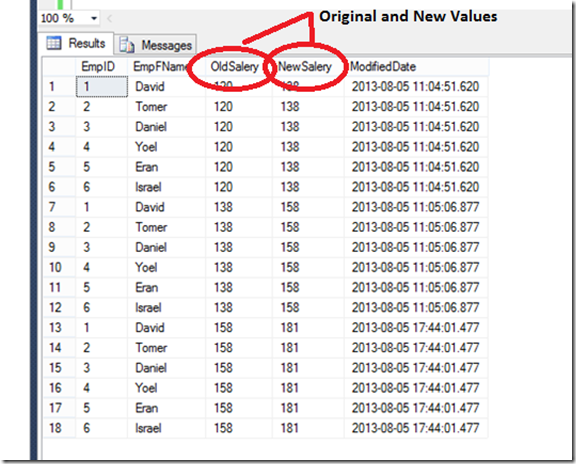Keep track of the DML changes:
Last week, one of my customers asked me how to track DML code.
He had a scenario in which he needed to update a table and keep the old data.
In the past, developers and DBAs have used custom code to track changes, stored procedures, triggers and CDC.
Starting with version 2005, SQL Server supports a simple method for auditing DML changes; the OUTPUT clause.
The OUTPUT command, collects the audited data into a table or a table variable. It enables us to track DML info of DELETE, UPDATE, INSERT & MERGE command.
The most common usage of the output command is in archiving processes. If we want to delete info from a business data table and archive the deleted data.
An important thing to know about OUTPUT:
When UPDATE, INSERT, or DELETE statements are cached in an OUTPUT clause, it will return rows to the client even if the statement encounters errors and is rolled back.
The result should not be used if any error occurs.
Example:
In this example we have an Employee salary table that we want to trace the salary changes.
In this scenario, the HR department of a big corporation would like to update all hourly tariff of the employees by 15% and keep the changes in an audit table for further action or for a fast rollback after testing the impact of the raise.
1: Create Database Output_Syntax
2: go
3: use Output_Syntax
4: go
5:
6: Create Table Emp_Hour_Rate(
7: Emp_ID intidentity,
8: EmpFName varchar(15),
9: Emp_Sal_H int,
10: Emp_hour int,
11: Emp_Sal AS ([Emp_Sal_H]*[Emp_hour]),
12: Mod_Date Datetime)
13:
14: Insert into Emp_Hour_RateValues ('David',120, 180,getdate()-1)
15: Insert into Emp_Hour_RateValues ('Tomer',120, 165,getdate()-7)
16: Insert into Emp_Hour_RateValues ('Daniel',120,192,getdate()-21)
17: Insert into Emp_Hour_RateValues ('Yoel',120,160,getdate()-32)
18: Insert into Emp_Hour_RateValues ('Eran',120,172,getdate()-32)
19: Insert into Emp_Hour_RateValues ('Israel',120,147,getdate()-12)
20:
21: Create table Audit_Sal(
22: EmpID int NOTNULL,
23: EmpFName varchar(15),
24: OldSalery int,
25: NewSalery int,
26: ModifiedDa tedatetime);
27:
28:
29:
30:
31: -- updateing a raise of 15% for
32: UPDATE Emp_Hour_Rate
33: SET Emp_Sal_H=Emp_Sal_H*1.15,
34: Mod_Date=GETDATE()
35: OUTPUT inserted.Emp_ID,
36: inserted.EmpFName,
37: deleted.Emp_Sal_H,
38: inserted.Emp_Sal_H,
39: inserted.Mod_Date
40: INTO Audit_Sal;
41:
42: --Display the result set of the table variable.
43:
44:
45: Select EmpID,EmpFName,OldSalery,NewSalery,ModifiedDate
46: FROM Audit_Sal
47:
48: Select * from Emp_Hour_Rate
49:
50: Usemaster
51: go
52:
53: drop database Output_Syntax
54: go
